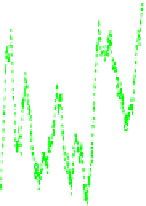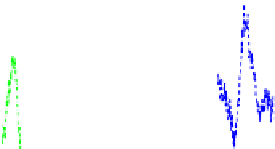Information Technology Reference
In-Depth Information
1
0.85
0.95
0.8
0.9
0.75
0.85
0.7
0.8
0.65
0.75
0.7
0.6
0.65
0.55
0.6
0.5
0.55
0.45
0.5
0
2
4
6
8
10
x 10
4
1.95
2
2.05
2.1
2.15
2.2
t
t
x 10
4
Fig. 5.
The time evolution of
Ψ
(
t
)(left)and
Ψ
(
t
) calculated in sliding window of
length equal to 100 (right) for
λ
-GCMG with
N
=1,
λ
=0
.
97 and strategies from
RSS. Red solid line corresponds to
m
= 1, dashed blue line corresponds to
m
=2,
green dashed-dotted line corresponds to
m
= 5. The predicted signal is FW20.
utility than the basic ones correctly recognizing shorter patterns. This happens
randomly, as sometimes samples are in order that is reflected by some of addi-
tional strategies. However, the pattern does not truly exist. In the next steps the
forecast, based on one of additional strategies, is mostly wrong, what lowers the
correctness. In other words, too long memory spoils the predictor introducing
noise of unwanted strategies. The observed degradation of correctness for longer
m
indicates that there are no long-range and complicated patterns in the signal
or that their nature is more subtle than MG strategies are able to capture. The
first statement is supported by observations of the autocorrelation of returns,
where the only distinct value is for
τ
= 1. Similar premise is also included in
Ref. [12].
The success rate for
m
=1,itismostlyabove0
.
6, and from time to time
even touches the level 0
.
8, if calculated in the sliding window. The mean value
of correctness is 0
.
7 (Fig. 5 - left), what seems impressive, at the first sight.
However, we checked that the correctness of the linear regression model of the
first order is equal to 0
.
68. The use of higher-order filters does not improve the
predictor.
The next question is, whether the results achieved for FW20 are specific only
for this asset or they are more universal. We examined separately 5 stocks with
the biggest impact on FW20 index (Fig. 6). The success rate decreases as a
function of
m
, regardless of the analyzed year. So the results seem to be time
and stock independent.
Another interesting issue is related to the analysis of the best strategy. The
question is, whether there is only one strategy permanently outperforming other
strategies or, maybe, different strategies lead at various moments? If there is only
one, it would mean that patterns do not change over the game or that they do in
a way the strategies are unable to capture. One permanently best strategy also
would mean that the extended adaptive version of algorithm is, at least in this

































































